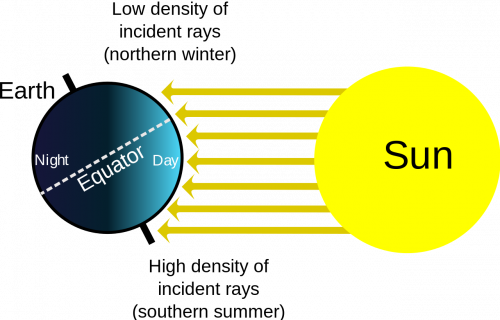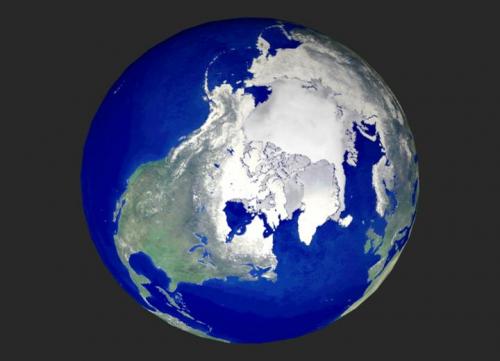This is the first journal in a series of posts explaining the science of our expedition.
The Arctic is often defined as the area north of the Arctic Circle. The Arctic Circle lies at a latitude of 66° 34' N, which is the location at which the sun does not set on summer solstice and does not rise on winter solstice. Even in summer, the angle of insolation is low, so the intensity of the Sun's energy hitting the Arctic is low. In addition, due to the ice and snow in the Arctic, the ground has a high albedo, meaning much of that solar energy is reflected into space. As a result, the Arctic receives little solar radiation so is very cold.
 The poles receive less solar radiation due to the tilt of the Earth.
The poles receive less solar radiation due to the tilt of the Earth.
It is a remote and harsh environment, where trees cannot grow. About four million people in seven countries span the Arctic, which represents only about 0.05% of the world's population. But this cold, dark, sparsely populated place is incredibly important for the rest of our planet.
The vast majority of the area above the Arctic Circle is water - the Arctic Ocean. This ocean is distinct because it is covered with sea ice. Historically, sea ice has covered almost the entire ocean in winter and a large portion in summer, though sea ice extent has decreased rapidly in recent decades.
 In winter, sea ice covers almost the entire Arctic Ocean.
In winter, sea ice covers almost the entire Arctic Ocean.
The Arctic's unique geography influes weather patterns in the rest of the Northern Hemisphere. The flow of a current called the Gulf Stream carries warm water from the Atlantic to cool in the Arctic, redistributing heat energy and influencing weather across the Northern Hemisphere. The Gulf Stream can impact humans in other ways, as well, such as shipping and fishing. Atmospheric currents in the Arctic also have important effects on the planet. One example, the Polar Vortex, is a circular current of air that traps cold air in the Arctic during the winter. If the Polar Vortex weakens, cold air can drop into the US and other mid-latitude countries, causing extreme cold spells despite an overall warmer planet. The Arctic is also important because of its human dimension. Many people rely on food from Arctic ecosystems, goods shipped through northern routes, or oil extracted from northern latitudes.
As Earth's temperature warms, scientists are seeing many changes in the Arctic. Temperatures rise faster here than the rest of the planet, leading to decreased sea ice extent and melted glaciers. By attempting to understand the Arctic, we may begin to understand how these shifts are changing large scale processes affecting the whole planet.


Add new comment